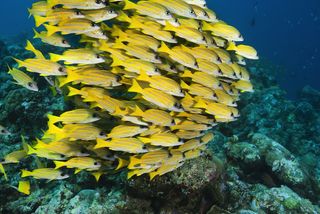Why Fish Don't Need to Be 'Schooled' in Swimming

How do fish swim in schools, effortlessly coordinating their every move? The answer appears to be ingrained in their genes.
The genetic basis underlying the complex, social behavior of schooling is revealed in two studies published Sept. 12 in the journal Current Biology. The studies suggest that schooling is not a learned behavior, and instead show it relies on several regions of the fish genome.
The findings may point to the genetic underpinning of why humans also are social, and tend to gather in groups, some experts said, although others debated this.
Stickleback to school
Most fish exhibit schooling during some phase of their life cycle, research has shown. Fish evolved to swim in schools to better protect themselves from predators, improve their foraging and swim more efficiently.
Unlike shoaling, in which fish merely swim loosely together, schooling requires coordinated body positions and synchronized movement. Fish in schools need to sense their environment with high accuracy, maintain awareness of their position within the school, and respond quickly to changes in both water currents and movement of the group.
Exactly how fish pull off this feat has remained elusive.
Sign up for the Live Science daily newsletter now
Get the world’s most fascinating discoveries delivered straight to your inbox.
In one of the new studies, researchers led by Catherine Peichel, a human biology researcher at the Fred Hutchinson Cancer Research Center in Seattle, studied sticklebacks, small fish about 3 inches (8 centimeters) long that live in both salt and fresh water. [Photos: The Freakiest-Looking Fish]
The researchers created a handful of fake fish models, suspended them in the water and whirled them about, to entice the real stickleback to join schools.
By crossbreeding one kind of stickleback prone to schooling with another kind of stickleback more reluctant to join a school, the researchers identified two genomic regions in sticklebacks associated with schooling. One of these regions is also associated with development of a highly specialized sensory structure unique to fish, known as the lateral line, which can detect vibrations in the water.
The lateral line is made up of cells called neuromasts, which are similar to the hair cells found in the human ear and enable the fish to sense changes in water currents and respond accordingly.
In the second study, researchers led by Clifford Tabin of Harvard Medical School in Boston studied the Mexican tetra, a freshwater fish also about 3 inches long that lives in open rivers and lakes, and sometimes in the streams of caves. The cave-dwelling variety is blind, and largely albino.
The surface-dwelling tetra swim in schools, but the blind cavefish do not, which suggested to the researchers that vision is important to schooling. But after crossbreeding the two varieties and conducting a genetic analysis, the team determined that as the cavefish evolved, they lost the ability to school, and they lost their vision in separate events.
This provided more evidence that schooling behavior is genetic-based and not learned, the researchers said.
Both research teams identified only genetic regions, not the exact genes, controlling the schooling behavior.
Of fish and men
The teams remained split, however, on how these findings may relate to humans. Anna Greenwood, a member of Peichel's team, said the findings could be applicable to complex social human behaviors.
"Because an evolutionarily shared neural circuit, as well as some of the same neurochemicals and hormones, control social behavior in all vertebrates, what we learn about genetic changes in fish could ultimately provide insight into human behavioral variation," Greenwood told LiveScience.
Hans Hofmann, a professor of integrative biology at the University of Texas at Austin, who was not involved in either study, said the stickleback work rebuts the assertion that human behavior is too complex to understand.
"I think it shows that even such complex behaviors associated with other individuals in a very rigid and organized manner can be dissected genetically," Hofmann said. "Studies like this tell us that we might get there eventually."
Tabin, however, said the findings of his Mexican cavefish study "do not tell us anything at all about human social behavior."
But he also said that both studies can tell researchers much about the evolution of schooling behaviors in fish, and that's what makes it worthwhile.
Follow LiveScience @livescience, Facebook & Google+. Original article on LiveScience.
